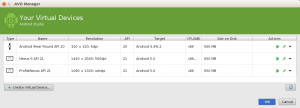Android Training/Running Your Application
If you followed the previous lesson to create an Android project, it includes a default set of "Hello World" source files that allow you to immediately run the app.
How you run your app depends on two things: whether you have a real device running Android and whether you're using Android Studio. This lesson shows you how to install and run your app on a real device and on the Android emulator, and in both cases with either Android Studio or the command line tools.
Run on a Real Device[Bearbeiten | Quelltext bearbeiten]
If you have a device running Android, here's how to install and run your app.
Set up your device[Bearbeiten | Quelltext bearbeiten]
- Plug in your device to your development machine with a USB cable. If you're developing on Windows, you might need to install the appropriate USB driver for your device. For help installing drivers, see the OEM USB Drivers document.
- Enable USB debugging on your device.
- On most devices running Android 3.2 or older, you can find the option under Settings > Applications > Development.
- On Android 4.0 and newer, it's in Settings > Developer options.
- Note: On Android 4.2 and newer, Developer options is hidden by default. To make it available, go toSettings > About phone and tap Build number seven times. Return to the previous screen to find Developer options.
Run the app from Android Studio[Bearbeiten | Quelltext bearbeiten]
- Select one of your project's files and click Run from the toolbar.
- In the Choose Device window that appears, select the Choose a running device radio button, select your device, and click OK .
Android Studio installs the app on your connected device and starts it.
Run the app from a command line[Bearbeiten | Quelltext bearbeiten]
Open a command-line and navigate to the root of your project directory. Use Gradle to build your project in debug mode, invoke the assembleDebug build task using the Gradle wrapper script (gradlew assembleRelease).
This creates your debug .apk file inside the module build/ directory, named MyFirstApp-debug.apk.
On Windows platforms, type this command:
> gradlew.bat assembleDebug
On Mac OS and Linux platforms, type these commands:
$ chmod +x gradlew $ ./gradlew assembleDebug
After you build the project, the output APK for the app module is located in app/build/outputs/apk/
Note: The first command (chmod) adds the execution permission to the Gradle wrapper script and is only necessary the first time you build this project from the command line.
Make sure the Android SDK platform-tools/ directory is included in your PATH environment variable, then execute:
adb install app/build/outputs/MyFirstApp-debug.apk
On your device, locate MyFirstApp and open it.
That's how you build and run your Android app on a device! To start developing, continue to the next lesson.
Run on the Emulator[Bearbeiten | Quelltext bearbeiten]
Whether you're using Android Studio or the command line, to run your app on the emulator you need to first create an Android Virtual Device (AVD). An AVD is a device configuration for the Android emulator that allows you to model a specific device.

Create an AVD[Bearbeiten | Quelltext bearbeiten]
- Launch the Android Virtual Device Manager:
- In Android Studio, select Tools > Android > AVD Manager, or click the AVD Manager icon in the toolbar.
- Or, from the command line, change directories to
sdk/and execute:
tools/android avd- Note: The AVD Manager that appears when launched from the command line is different from the version in Android Studio, so the following instructions may not all apply.
- On the AVD Manager main screen (figure 1), click Create Virtual Device.
- In the Select Hardware window, select a device configuration, such as Nexus 6, then click Next.
- Select the desired system version for the AVD and click Next.
- Verify the configuration settings, then click Finish.
For more information about using AVDs, see Managing AVDs with AVD Manager.
Run the app from Android Studio[Bearbeiten | Quelltext bearbeiten]
- In Android Studio, select your project and click Run from the toolbar.
- In the Choose Device window, click the Launch emulator radio button.
- From the Android virtual device pull-down menu, select the emulator you created, and click OK.
It can take a few minutes for the emulator to load itself. You may have to unlock the screen. When you do, My First App appears on the emulator screen.
Run your app from the command line[Bearbeiten | Quelltext bearbeiten]
- Build the project from the command line. The output APK for the app module is located in
app/build/outputs/apk/. - Make sure the Android SDK
platform-tools/directory is included in yourPATHenvironment variable. - Execute this command:
adb install app/build/outputs/MyFirstApp-debug.apk
- On the emulator, locate MyFirstApp and open it.
That's how you build and run your Android app on the emulator! To start developing, continue to the next lesson.
Portions of this page are modifications based on work created and shared by the Android Open Source Project and used according to terms described in the Creative Commons 2.5 Attribution License.
